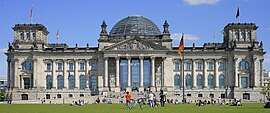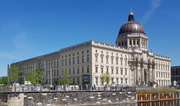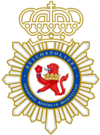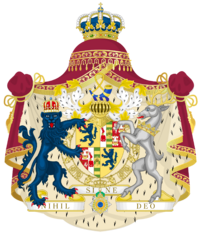Königsreh: Difference between revisions
mNo edit summary |
|||
| Line 130: | Line 130: | ||
==Politics== | ==Politics== | ||
===As the Mascyllary capital=== | ===As the Mascyllary capital=== | ||
{{main|Monarchy of Mascylla|Government of Mascylla|Prime Minister of Mascylla|Reichsrat (Mascylla)|Reichssenat}} | |||
Since 1818, the [[Monarchy of Mascylla|royal family]] maintains their {{wp|official residence}} in [[Monarchy of Mascylla#Residences|Lobrecht Palace]]. Prior to this, by 1808, most of the government authorities, most notably the ''[[Reichsrat (Mascylla)|Reichsrat]]'', [[Reichssenat]], and the [[Government of Mascylla|Royal Government]], had relocated from Lancaide to Königsreh. In 1808, the ''Reichsrat'' held its first parliamentary session in [[Colmar Palace]] (''Palais Cholmar''), and in 1815, [[Thrayn Palace]] (''Palais Thrayn'') was inaugurated and first obtained by [[Prime Minister of Mascylla|Prime Minister]] [[Prime Minister of Mascylla|Wilhelm Fürst von Stenreck]]. Ultimately, both residences would be replaced by the Kronenrat building (''Kronratsgebäude'') and the ''Reichsrat'' building (''Reichsratsgebäude'' or simply ''Reichsrat'') in 1839 and 1866, respectively. All 16 ministries and agencies of the Royal Government and Privy Council have their mean seat in Königsreh, but also operate secondary albeit ceremonial seats in Langquaid. Most of the national government's official releases (''[[Reichsgesetzschrift (Mascylla)|Reichsgesetzschrift]]'') and statements (''[[Reichsankündigungen (Mascylla)|Reichsankündigungen]]'') are still being released in the other city to this day, and no high court is located in Königsreh, but in [[Augusthal]], [[Lensrau]], and [[Lehpold]]. | |||
Roughly 25 {{wp|sovereign state}}s have their {{wp|embassy}} to Mascylla in Königsreh, while the 14 federal states and free cities have additional representative offices and missions. A large number of diplomatic representations are located in the ''[[Diplomatenviertel, Königsreh|Diplomatenviertel]]'' and in the [[Prinzenwald, Königsreh|Prinzenwald]] district in the city centre. International organisations such as the [[Telmerian Union]] (TU), [[UPESCH]], and the [[BDTA]] also maintain representative offices, and Königsreh is host to the [[Assembly of Nations|headquarters of the Assembly of Nations]] (AN). | |||
As the seat of government of the [[List of Auroran countries by different metrices|single largest economy in Berea]], Königsreh is one of the influential and sought-after centers of Berean politics. {{wp|Political party}} headquarters, {{wp|labor union|labor and trade unions}}, {{wp|foundation (nonprofit)|foundations}}, {{wp|voluntary association}}s and {{wp|lobbying|lobby}} representations of companies are all maintaining seats and offices in the city. {{wp|State visit}}s and receptions on every political level as well as important celebrations characterize Königsreh's annual political calendar. | |||
{{Gallery | |||
As the seat of government of the [[List of Auroran countries by different metrices|largest economy in Berea]], Königsreh is one of the influential and sought after | |title= | ||
|width=180 |height=120 | |||
|align=center | |||
|footer= | |||
|File:Lobrecht Palace in Königsreh.png | |||
|alt1= | |||
|Lobrecht Palace (''Lobrecht-Palast''), official residence of the [[Monarchy of Mascylla|Mascyllary monarch]] since 1818 | |||
|File:Bellevue_Palace_Berlin_02-14.jpg | |||
|alt2= | |||
|''Kronenratsgebäude'', seat of the [[Government of Mascylla|Royal Government]] and the [[Prime Minister of Mascylla]] since 1839 | |||
|File:Reichstag_building_Berlin_view_from_west_before_sunset.jpg | |||
|alt3= | |||
|''Reichsratsgebäude'', seat of the ''[[Reichsrat (Mascylla)|Reichsrat]]'' since 1866 | |||
|File:Cámara_Alta_de_Prusia,_Berlín,_Alemania,_2016-04-22,_DD_49-51_HDR.jpg | |||
|alt4= | |||
|''Reichssenatsgebäude'', seat of the ''[[Reichssenat]]'' since 1898 | |||
|File:Abgeordnetenhaus.jpg | |||
|alt5= | |||
|''Königsreher Abgeordnetenhaus'', Chamber of Deputies of Königsreh since 1900 | |||
}} | |||
===As the state of the Kronlande=== | ===As the state of the Kronlande=== | ||
Revision as of 20:13, 2 January 2023
This article is incomplete because it is pending further input from participants, or it is a work-in-progress by one author. Please comment on this article's talk page to share your input, comments and questions. Note: To contribute to this article, you may need to seek help from the author(s) of this page. |
Königsreh | |
|---|---|
| Free Capital City of Königsreh Freie Reichshauptstadt Königsreh | |
From top, left to right: Köpenick city skyline, St Lorenz Cathedral in front of the Königsreh Signal Tower, Victory Gate, Academy of the Arts on Palace Island, Köpenick Palace, Kürassierenmarkt with the Konzerthaus, flanked by the Mascyllary Church (left) and the Cuthish Church (right), Reichsrat Building | |
| Country | |
| State | Königsreh |
| Founded | 21 March 1811 |
| Government | |
| • Mayor | Paul Friedrich Choldwig (RU) |
| Area | |
| • Capital city and federated state | 928.9 km2 (358.7 sq mi) |
| Elevation | 48 m (85.30 ft) |
| Population (2018) | |
| • Capital city and federated state | 3,231,326 |
| • Density | 3,482/km2 (9,020/sq mi) |
| • Metro | 7,311,177 |
| Demonym(s) | Konigsrehers (Fallish), Königsreher (m), Königsreherin (f) (Hesurian) |
| Time zone | UTC+2 (EST) |
| Postal code | 01 |
| Area code | 536 |
| Vehicle registration | KR |
| Website | koenigsreh.ma |
Königsreh or Konigsreh (Hesurian: [kø:nɪksʁe:]), officially the Free Capital City of Königsreh[a], is the capital and second-largest city of Mascylla. It is populated by 3,231,326 (2017) inhabitants, making it one of the most populous cities propers in Berea, and second only to Flussmund in Mascylla. The city and its surrounding adjacent urban agglomeration is one of Mascylla's 18 federated states, and it is surrounded by the states of Eustria–Folnery, Shwesia, Nelgery, and Falia. Together with Flussmund up north it forms the second-most populous metropolitan area in the country, referred to as the statistical Königsreh–Flussmund Greater Metropolitan Area (Metropolregion Königsreh-Flussmund), closely behind the Elbgau–Blaugold region (Elbgau-Blaugold-Gebiet).
In the aftermath of the establishment of the Mascyllary Kingdom, Königsreh was developed and constructed as a planned city by Ernst Ignatius von Gneisloe. In 1811, the arrival of Lucas I and his court to the Royal Palace (Königliches Schloss) as well as the first session of the Reichssenat officially inaugurated Königsreh as the capital city of Mascylla, replacing Lancaide. Königsreh quickly evolved into a large metropolitan area during the Gründerjahre and Neuzeit, becoming the third-largest city in the world by the 1920s. The city served as the historical seat of government of the Mascyllary Kingdom (1793–1923), the short-lived May Republic (1923–1924), and the Crowned Republic of Mascylla (1924–present).
The city lies on the banks of the River Blaugold, which flows through the city centre towards the Mascian Bight of the North Sea. Various smaller lagoons and lakes dominate Königsreh's topographical makeup in the western and southern boroughs, and an abundance of greenery, forests, parks, rivers, canals, and gardens largely shape the cityscape. Due to its location in the Great Mascyllary Plain and Königsreh Bay, Königsreh receives a temperate and seasonal climate.
A global city and hub according to the Newcott World Cities Index, Königsreh is often referred to as one of the world capitals of culture, finance, and media, and exerts a significant influence upon commerce, entertainment, art, fashion, sports, technology and research, education, politics, and tourism. Home to the headquarters of the Assembly of Nations, Königsreh is an important center for international diplomacy. The service-based and highly entrepeneurial economy of Königsreh is populated by high-tech and IT firms, biomedical engineering companies and the healthcare industry, automotive manufacturing, cleantech and other startups. The city of high standard of living is well known for its multiculturalism, nightlife, contemporary lifestyle, and high social attractiveness, as is the internationally well-known Landherrenallee.
Major landmarks of Königsreh are the Victory Gate, the Reichsrat building, the scenic Straße der Krone, the Assembly of Nations headquarters, the Königsreh Column of the Great War, Lobrecht Palace, Köpenick Palace, St Lawrence Cathedral, and the Fernsehturm Königsreh. Its zoological institutes, encompassed in the Zoologischer Park, is the most frequently visited zoo in Berea. Ellingerode was the world's first large-scale film studio complex and continues to be a global center of the television and motion picture industry, hosting award shows of international acclaim such as the annual Mastery Awards. The historical city centre is a popular tourist destination, with renowned universities, orchestras, museums, and galleries; these include the Hährnig University, the Technical University, the New University, the University of the Arts, the TSEM, the Palace Island, the National Gallery, the Pergament Museum, the Old Museum, the New Museum, the Academy of the Arts, the National History Museum, the Royal Library and Opera, and the Königsreh Philharmonic.
History
Prior to construction
Gneisloe plan and construction (1794–1811)
Königsreh is the last major Berean city to have been planned and constructed as a planned city. King Lucas I sought to replace the late medieval Lancaide as his established residence with a new city that was open in layout, flexible for further expansion, and befitting of his new station as Mascyllary King. According to popular myth, Lucas I barely survived a direct confrontation with a red deer while out hunting in the Horenforst, and in gratitude, chose to erect his residence named after that particular animal; however, historians generally agree that its strategically valuable location at the River Blaugold and at the Meißert Gap was carefully selected.
Beginning in 1794, Lucas I had his imagined city designed by architect and scholar Ernst Ignatius von Gneisloe who took major inspiration from the royal Shwesian residence of Carlsweil, and attended the groundbreaking of the City Palace (then named Lucas Palace, Lukasschloss) designed by Heinrich von Kayffshausen on 1 August 1795.
The actual reasonings behind the city's location and name have never been fully ascertained. The system of roads and pathways radiating outward, which is generally understood to be a physical embodiment of political absolutism itself, corresponds to the design of a "hunting star" (Jagdstern) and the landscape design principles of a Lavish formal garden, and opened up the Horenforst as royal hunting grounds. Little of the original design remains today, though the Straße der Krone is one of two major axial roads still present and in use by pedestrians and vehicles. The Tower Wing (Turmflügel) of the City Palace served as a minor hunting lodge (Jagdschloss) and residence for pleasure (Lustschloss) while construction was ongoing; it was not until 1811 that Königsreh was suited for occupation by the royal court. In 1808, the Reichsrat held its first parliamentary session in Colmar Palace (Palais Colmar), and most of the Royal Government had relocated to new seats in Königsreh. From 1799 to 1808, the city became a heavily fortified citadel with 16 bastions.
On 21 March 1811, the Royal Palace finished construction, and Lucas I officially proclaimed Königsreh to be his official residence (Residenz- und Hauptstadt Königsreh) with the royal assent of the Capital City Act (Hauptstadtbeschluss). As a result, the town, which grew around the Royal Palace in the 17 years of active construction, was merged with the towns and Vorstädte of Auguststadt, Lukasstadt, Königsstadt, Jungfernheide, and Spadowstadt; the population rose to approximately 40,000 by 1800 and following the administrative merger.
Aldia and Mascyllary Kingdom (1811–1916)
With the Act of Privileges (Privilegienbeschluss) of 9 October 1812, Prime Minister Wilhelm Fürst von Stenreck created incentives for immigration and settling in Königsreh. By 1820, the city had developed into one of the epicenters of Mascyllary culture, and its metropolitican bourgeois culture ushered in the era of Königsreh Classicism. Religious and social tolerance during this period made Königsreh one of the main centers of the late Enlightenment in Berea, despite efforts by Lucas I and his successor, Lucas II, to suppress Cuthish revolutionary thought.
During the Königsreh Fire of 1818, the Royal Palace was almost entirely destroyed; Lucas II was forced to acquire Lobrecht House from Wilhelm Günther Graf von Lobrecht and convert it into a royal residence under heavy financial strain.

After Mascylla's defeat at the hands of Edwin III's armies during the Alhstead Second Cutho-Mascyllary War, King Lucas II fled from the capital for Carnitz. Authorities and wealthy families similarly left the city. Cuthish troops encircled and besieged Königsreh, forcing an unconditional surrender in autumn of 1840, and occupying it for approximately a year. The new Königsreh City Ordinance (Königsreher Städteordnung) was passed in 1841 under the reformer Emmanuel Heinrich Freiherr von Lyder, leading to the creation of the first freely elected city council; a First Mayor (Oberbürgermeister), Werner Leibig, was elected to head the new self-governing administration, referred to as the Senate (Senat), and took up office in the Old City Hall.
The establishment of a Königsreh university, proposed by Philipp Alexander von Hährnig, played a significant role in the reform process under Cuthish military administration; the new university quickly became the intellectual center of Königsreh. Further reforms such as the introduction of a corporate tax and the abolition of professional guilds under State Chancellor Georg Karl von und zu Lichtenberg led to renewed economic and population growth in the city and laid the foundations for early industrialization. Lucas II returned to Königsreh in 1842 but was not successful in reversing the implemented reforms. With the onset of the Second Industrial Revolution, a large number of factories and manufacturing plants were erected outside the city walls, attracting more immigrants who found employment as workers or day laborers. Königsreh's population nearly tripled from 120,000 to about 330,000 inhabitants until 1850, becoming the second-largest Mascyllary city after Flussmund. Companies such as Herber, Reuthers, Koldmeier, and UGE emerged and soon transformed Königsreh into an industrial city of national and later international importance. This development was accompanied by the political rise of its labor movement, which became one of the strongest of its kind in the world.
The Mascyllary Revolution of 1847 had its origin in Königsreh and prompted Queen Sophia to make numerous concessions. In 1849, a city constitution and new municipal code was introduced, granting constituents the freedom of the press and freedom of assembly. However, on the other hand, the continuation of the three-class franchise, the restrictions imposed on the political power of individual city counselors, and the strengthened position of chief of police Ernst von Haydenfels caused public outcry. The rising prominence of the Reichsrat as a political institution precipitated the construction of the present-day Reichsrat building from 1858–1866. During Sophia's reign, she was personally responsible for the development of the city's infrastructure, its public utilities, sewerage, water supply, and the maintenance of public spaces. The rapid population increase, paired with persistent poverty and large-scale property speculation, led to precarious living conditions in the tenements of the sprawling workers' quarters typical of the city.
In the latter 19th century, the Gründerjahre and the Neuzeit saw Mascylla rising to become a great power, and Königsreh developing into a major global city. In 1874, Königsreh initially became a city of over 1 million inhabitants, but by 1909, its population exceeded some 2 million due to overwhelmingly rapid urbanization. Königsreh was almost encircled and repeatedly bombed by Cuthish forces in the Great War (1911–1916), killing well over 5,000 civilians and heavily damaging swaths of the city center.
Crowned Republic and contemporary history (1916–present)
After the Great War, revolutionary sentiment culminated in the proclamation of a republic in Königsreh on 23 May 1923 by Friedrich Estermann. In the months following the Mascyllary Revolution, repeated and often times bloody clashes between the government, supported by right-wing Freikorps, and left-wing revolutionary forces shook the capital. The 1923 November Uprising (Novemberaufstand) and subsequent December Struggle (Königsreher Dezemberkämpfe) saw the use of field guns, mortars, and fighter aircraft against the civilian population. A total of 1,950 people died in the fighting from 21 November to 9 December.
In April of 1924, the Litten Putsch, initiated by opposition military forces, forced the Königsreh government to flee from the capital but ultimately failed due to determined resistance and a general strike of large portions of the populous. Later that year, the establishment of Greater Königsreh (Groß-Königsreh) saw the political and administrative incorporation of several surrounding towns, rural communities, and expansive estate districts, the largest of its size in the city's history. The expanded city now had a population of some 4 million inhabitants, making it the fourth-largest city worldwide in the 1920s and 1930s and a global center of art, culture, science, technology, and industry during the "Roaring Twenties".
Geography
Location
Topography
Parks and nature
Climate
City administration
Demographics
Cityscape and architecture
Politics
As the Mascyllary capital
Since 1818, the royal family maintains their official residence in Lobrecht Palace. Prior to this, by 1808, most of the government authorities, most notably the Reichsrat, Reichssenat, and the Royal Government, had relocated from Lancaide to Königsreh. In 1808, the Reichsrat held its first parliamentary session in Colmar Palace (Palais Cholmar), and in 1815, Thrayn Palace (Palais Thrayn) was inaugurated and first obtained by Prime Minister Wilhelm Fürst von Stenreck. Ultimately, both residences would be replaced by the Kronenrat building (Kronratsgebäude) and the Reichsrat building (Reichsratsgebäude or simply Reichsrat) in 1839 and 1866, respectively. All 16 ministries and agencies of the Royal Government and Privy Council have their mean seat in Königsreh, but also operate secondary albeit ceremonial seats in Langquaid. Most of the national government's official releases (Reichsgesetzschrift) and statements (Reichsankündigungen) are still being released in the other city to this day, and no high court is located in Königsreh, but in Augusthal, Lensrau, and Lehpold.
Roughly 25 sovereign states have their embassy to Mascylla in Königsreh, while the 14 federal states and free cities have additional representative offices and missions. A large number of diplomatic representations are located in the Diplomatenviertel and in the Prinzenwald district in the city centre. International organisations such as the Telmerian Union (TU), UPESCH, and the BDTA also maintain representative offices, and Königsreh is host to the headquarters of the Assembly of Nations (AN).
As the seat of government of the single largest economy in Berea, Königsreh is one of the influential and sought-after centers of Berean politics. Political party headquarters, labor and trade unions, foundations, voluntary associations and lobby representations of companies are all maintaining seats and offices in the city. State visits and receptions on every political level as well as important celebrations characterize Königsreh's annual political calendar.
Lobrecht Palace (Lobrecht-Palast), official residence of the Mascyllary monarch since 1818
Kronenratsgebäude, seat of the Royal Government and the Prime Minister of Mascylla since 1839
Reichsratsgebäude, seat of the Reichsrat since 1866
Reichssenatsgebäude, seat of the Reichssenat since 1898
As the state of the Kronlande
Königsreh as an Imperial Free City (Freie Reichsstadt) is an autonomous federal state in Mascylla, the Kronlande. The Kronlande solely encompasses the City of Königsreh (Stadt Königsreh) per definition. The state itself is divided into seventeen boroughs, while each of them are further subdivided into neighbourhoods.
The parliament of the state that exercises legislative power is the House of Deputies of Königsreh (Abgeordnetenhaus von Königsreh), in which deputies of the SDP, RU, MDP, NDU, Independent Voters and VP are seated. As of 2022, the government is led by the SDP, in coalition with the MDP and RU. The Senate of Königsreh (Königsreher Senat), consisting of the Mayor (Bürgermeister) and ten additional senators, makes up the government of the state (Landesregierung). While the Mayor is responsible for political affairs of the state, the ceremonial head of state is the currently reigning monarch since 1803. The senator administrations have similar tasks as its counterparts in the Mascyllary government.
Subdivisions
City services
The state of the Kronlande as well as every other state and free state in Mascylla is served by the Imperial Police (Reichspolizei). It is subdivided into eight local directives, as well as the Kronlande Criminal Agency (Kriminalamt Kronlande). The police service employs around 21,500 people, 17,900 of which officers and the remaining 3,600 support staff and administration, making it the largest localized police service in Mascylla.
The Königsreh Fire Department (Königsreher Feuerwehr), being founded in 1870, is the oldest continuous fire department of Mascylla. With its 3,980 employers and up to 31 fire stations it is also the biggest urban fire department in the country. It is supported by 50 voluntary fire brigades with approximately 1,220 active unsalaried members and partly made up of the Städtisches Hilfswerk (SHW) in Marienfelde.
Coat of arms and flag
The coat of arms of Königsreh depicts a sitting, white deer with a golden antler and golden hooves in a golden shield. Sometimes the crown of the Mascyllary monarchs is depicted to crown the coat of arms to symbolize the unique status of the city. The deer is the namesake of the city and is derived from the heraldry of the House of Ahnern and therefore the first king who founded the city, Lukas I of Mascylla. The colours of the shield, green and yellow, reflect the city's abundance in nature and its royal status, respectively.
The state flag of Königsreh is composed of two horizontal stripes of green above and yellow below. It is a continued design with few stilistic differences since it was first flown in 1862. Previously, the flag featured the coat of arms in between the two stripes on a white background, but it was redacted since it appeared too similar with the flag of Eustria and was too complex to identify from far away.
The uniformed statute of waving flags (in front of state authority buildings):
Flag of the Telmerian Union
Flag of the Berean Defence Treaty Association (for specific events and buildings)
Urban partnerships
The city of Königsreh maintains city partnerships with ![]() Lilienburg City, Lilienburg (1947),
Lilienburg City, Lilienburg (1947), ![]() Tinz am Sigmund, Temaria (1966),
Tinz am Sigmund, Temaria (1966), ![]() Aniarro, Lavaria (1968),
Aniarro, Lavaria (1968), ![]() Kristianshavn, Norden (1971),
Kristianshavn, Norden (1971), ![]() Ulich, Dulebia (1985),
Ulich, Dulebia (1985), ![]() Toulogne, Sarrac (1988), and
Toulogne, Sarrac (1988), and Sydenham, Falland (1988).
Infrastructure
Public transport
Motor traffic
Air traffic
Media
Economy
Science and education
Culture
Notes
- a.^ Hesurian: Freie Reichshauptstadt Königsreh, IPA: [fʁaɪ̯ə ʁaɪ̯çshaʊ̯ptʃtat kø:nɪksʁe:]























